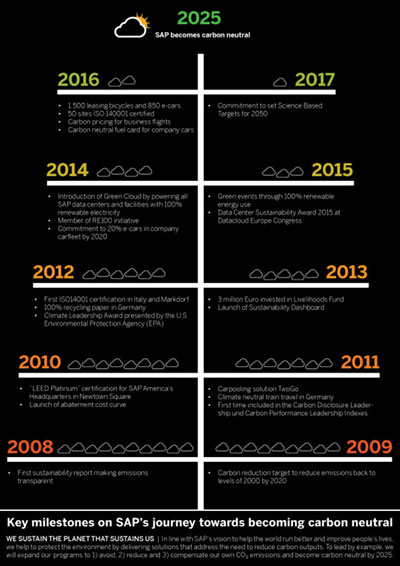
Dell EMC and Nokia Team Up on Digital City Project to Deliver Goods using Semi-Autonomous Barges in the City of Delft
December 11, 2018
What SAP is Doing to Address Climate Change
December 11, 2018For many of us, it’s that usual time of year — Q4 and the pressure is on to make it across the finish line. We’re also deep in planning for the coming year.
Teams gather and present what they expect to achieve, provide the data to demonstrate how it will impact the business, and then they ask for the budget needed to make it all happen. It’s up to business and financial leaders to decide what the priorities will be, and how to allocate limited resources.
In the past, a comprehensive talent strategy was often that one missing piece to a successful business plan. But times are changing.
CEO Challenges: Addressing Future Talent Needs
Today, CEOs realize the critical importance that talent and the right talent strategy are to their company’s growth and success.
In my more than 20 years as an HR leader, I’ve partnered with many executives focused on driving transformation in their businesses—they know that effective talent management and the ability to adapt to changing workforce dynamics are critical to successfully competing, and winning, both today and in the future. But acknowledgement is only the first step. Understanding how to identify and address future talent needs is a big challenge for many businesses, and yet critical to driving true business success.
Talent Data is Key
The solution, without surprise, is access to data. I’m not talking about data that takes countless hours to pull together into cumbersome charts and spreadsheets. I mean fast, real-time data that can keep the speed of decision-making at the pace a CEO wants their business to move.
If you’re in HR, you already know there are two data types that every leader should have at their fingertips. There are the basic statistics that show the current talent snapshot, including a company’s number of employees with a breakdown by who’s considered top talent, who and how many are at risk of leaving, and whether those at risk have succession plans in place, to name a few.
There is also the more forward-looking information that can offer valuable insights to address critical planning needs. What future skills do we need and who has these skills today? What will it cost to hire or train for the skills we don’t yet have? And what actions do we need to take to drive diversity initiatives?
Technology that Turns Data into Insights
With the right tools, HR can be a strategic player in helping drive business transformation. Technology is the number one factor that will help change the way we work and put talent at the forefront of every transformation strategy.
Point solutions will only get you partway there.
SAP SuccessFactors is a comprehensive human capital management solution suite that helps provide visibility into a company’s global talent. The unified suite of solutions simplifies and seamlessly integrates all talent management processes, enabling CEOs to build their next generation of talent and make future business plans come to life. Processes like succession planning, performance management, and recruiting are automated, more continuous, and intelligent transforming the workforce experience across the entire talent lifecycle.
Succession Planning for the Future
Let me give you an example: HR practitioners know that proactively planning for the inevitable changes that occur when employees resign, retire, or move into another role ensures their business doesn’t miss a beat during the transition. But when you’re dealing with a large and global workforce, knowing who’s out there can be challenging.
At SAP, we build searchable talent pools in addition to succession planning to identify where we have bench strength and where there are gaps in a much more agile and transparent way. We use these insights to make real-time decisions on whether to develop internal talent or prepare for external sourcing. This agility ensures no gap in filling roles which has a profound impact on not only financials but also employee motivation and commitment.
If we decide to develop talent internally, we use our technology to identify who meets the criteria for specific roles and skillsets. If we decide to recruit, we rely on our talent acquisition solutions to help streamline and speed up the process. In addition, our suite-wide Business Beyond Bias functionality helps ensure we continue to proactively build an inclusive and diverse workforce by identifying unintended biases in talent decision-making – including whom to hire, and whom to develop, reward, and promote, for example.
Recruiting Made Simple
We all know from experience how much time it can take to fill just one role. This is due to the fact that many recruiting organizations do not proactively source and nurture talent pools. Yet in today’s environment and given the war for talent, this has become a necessity. Imagine sourcing talent and actively engaging with internal and external candidate pools in mere minutes—it would dramatically speed up the time to fill roles and minimize any downtime.
Recently, I needed an HR business partner in Israel. The candidate needed to be fluent in Hebrew, willing to relocate and have an HR background. I used SAP SuccessFactors Recruiting, and its embedded candidate relationship management capabilities, and I was able to not only identify but also engage an ideal candidate in a few minutes. The irony is, I knew this person, but didn’t know the breadth of his skillsets!
Even more powerful is finding talent you had no access to without the use of technology. I used the same talent tool to identify a COO candidate and was pleased to find a talent in Finland that had never surfaced in a talent review, but whose skills were a match for the role I was looking to fill. After a conversation with her manager, she quickly engaged in the interview process, was selected and was on her way to America with her family on a relocation package –in less than three months, from start to day one on the job.
No binders, no spreadsheets, just real-time, intelligent talent pools and the openness of leaders to explore and implement new sourcing strategies.
People are Your Most Important Asset
Whether you’re planning for tomorrow, 2020, or 2025, looking at your talent needs for the short and long-term is a true differentiator for the success and longevity of your business.
Come to the table with the right set of tools and actionable data, and you’ll solidify the role HR plays in placing a company’s number one asset—its people—as the starting point for your CEO’s strategic planning.
Welcome to the Human Revolution. We are here to proclaim that the old ways of working no longer work for HR. SAP SuccessFactors helps you bring your organization’s purpose to life and more meaning to people’s work. You can instill intelligence across your HR functions to develop engaged, motivated teams. Together, we’ll create an inspired workforce that improves both performance and profit.
Brigette McInnis-Day is chief operating officer for SAP SuccessFactors.




